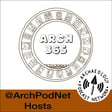Become a Creator today!Start creating today - Share your story with the world!
Start for free
00:00:00
00:00:01

Jelling - Episode 18029
Today Jelling is a small town of less than 4000 people, however, it is considered to be the site of the the founding of modern Denmark.
Recommended
Transcript
Podcast Introduction
00:00:01
Speaker
You're listening to the Archaeology Podcast Network. Once a home for kings, this small town boasts an intriguing array of Viking age monuments. This is episode 29 for January 29th, 2018. I'm Chris Webster and welcome to the ARC 365 podcast 2018 edition. ARC 365 is a podcast a day, every day in 2018.
00:00:27
Speaker
This network is supported by our listeners. You can become a supporting member by going to arcpodnet.com slash members and signing up. As a supporting member, you have access to high quality downloads of each show and a discount at our future online store and access to show hosts on a members only Slack team.
00:00:45
Speaker
For professional members, we'll have training shows and other special content offered throughout the year. Once again, go to arcpodnet.com slash members to support the network and get some great extras and swag in the process. That's arcpodnet.com slash members.
Gelling and the Founding of Denmark
00:01:05
Speaker
Today, Gelling is a small town of less than 4,000 people. However, it is considered to be the site of the founding of modern Denmark. Though the evidence of human activity here dates back to at least the Bronze Age, the Viking period is the time which has left the most visible marks on Gelling. The most obvious remains from this period are the two mounds. Each one is around 70 meters in diameter and 11 meters high and both of them appear to be built in an identical manner. Layers of turf carefully stacked with the grass side facing down.
00:01:31
Speaker
The north mound is possibly the earlier of the two, with current dating placing it to between 958 and 959 CE, based on dendrochronological dating. This would place it around the death of King Gorham the Old.
00:01:43
Speaker
It appears to originally have been a Bronze Age mound that was repurposed by Gorm's son, Harold Bluetooth, and enlarged to house the remains of the dead king. It contained a wooden chamber in which the body and grave goods were most likely placed. The mound was dug into sometime in the 10th century when it seems that Gorm's remains were removed to the church. In more recent times, it was dug into in the 19th century. One of the more iconic finds from this mound is a small silver cup which is highly decorated and is the type piece which gives its name to the gelling art style.
00:02:10
Speaker
The south mound was probably built in 970 and despite extensive excavations, it appears to contain no burial.
Gelling's Archaeological Significance
00:02:17
Speaker
One theory claims that it was built to honor Thyra in an effort to lay claim to land that she may have owned. And she may have had a second marriage to a man named Two.
00:02:26
Speaker
The ship setting found at Gelling is the largest known to date. A ship setting or stone ship is a formation of usually upright stones that are arranged in the shape of what most would call a Viking ship. The one at Gelling is 354 meters long or 1200 Roman feet. This measurement may be of some importance as there are Viking-age circular fortresses that also have this as their diameter.
00:02:47
Speaker
Ship settings were in construction in Scandinavia from 1000 BCE to 1000 CE, most likely as some form of funerary monument. It appears that the north mound is at the center of the ship setting and that it was 20-30 years old before part of it was covered by the south mound.
00:03:02
Speaker
The Runestones are possibly the most important monuments of Gelling. The first was installed by Gorham the Old to his wife Thyra. It may have also formed the prow of the ship's setting. The second, and by many measures, most important Runestone is that which was raised by Harold. Though honoring his parents, this stone has more important historical and political ramifications.
00:03:22
Speaker
The text of this reads, This is the first mention of Denmark as a country.
00:03:38
Speaker
It has even been said by a Danish artist in the 1930s that this is Denmark's baptismal certificate. However, a lot of the Danes may have been Christian or at least partially so long before this. There have even been some Christian objects found in the burial chamber in the north mound. Today the stones are enclosed in glass to protect them from the elements.
00:03:55
Speaker
The archaeology of Gelling has much more to offer from the recently discovered palisade that surrounds all the previously mentioned monuments to the church and the church remains.
Podcast Network and Support
00:04:03
Speaker
It is well worth a visit, particularly at the museum, which was reopened in 2015 after renovations. Gelling was inscribed as a UNESCO World Heritage Site in 1994. Thank you.
00:04:20
Speaker
Thanks for listening to Arc 365. If you want to hear more Arc 365, check out www.arcpodnet.com slash Arc 365 for the 2017 and 2018 episodes. Check out arcpodnet.com slash Arc 365 dash G30 for the last 30 episodes. Please subscribe and rate on your service of choice. We're available on iTunes, Stitcher, and Google Play, among others. Support the APN at arcpodnet.com slash members. Thanks for listening and thanks for being awesome.
00:04:50
Speaker
This show is produced and recorded by the Archaeology Podcast Network, Chris Webster and Tristan Boyle, in Reno, Nevada at the Reno Collective. This has been a presentation of the Archaeology Podcast Network. Visit us on the web for show notes and other podcasts at www.archpodnet.com. Contact us at chrisatarchaeologypodcastnetwork.com.
